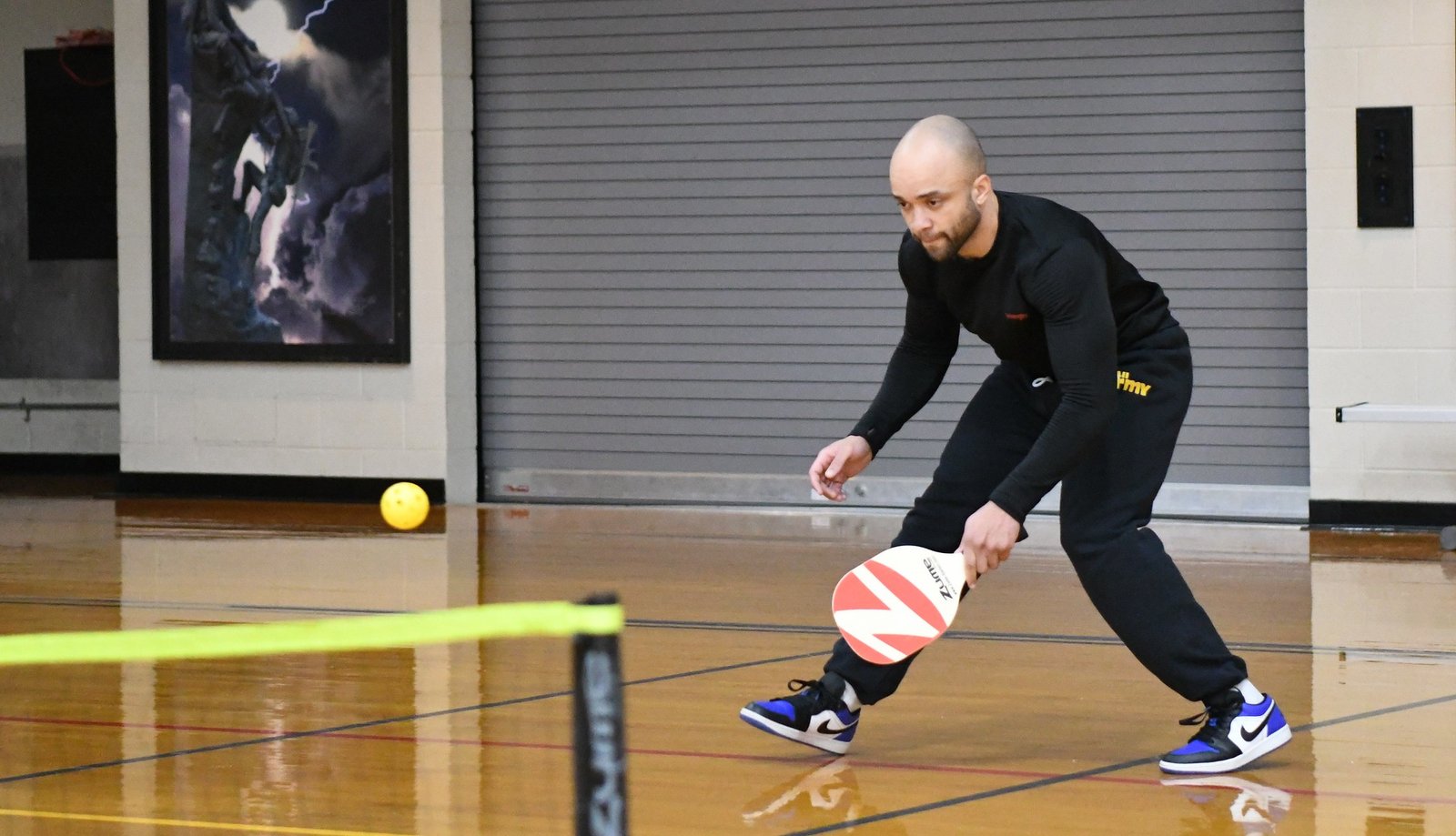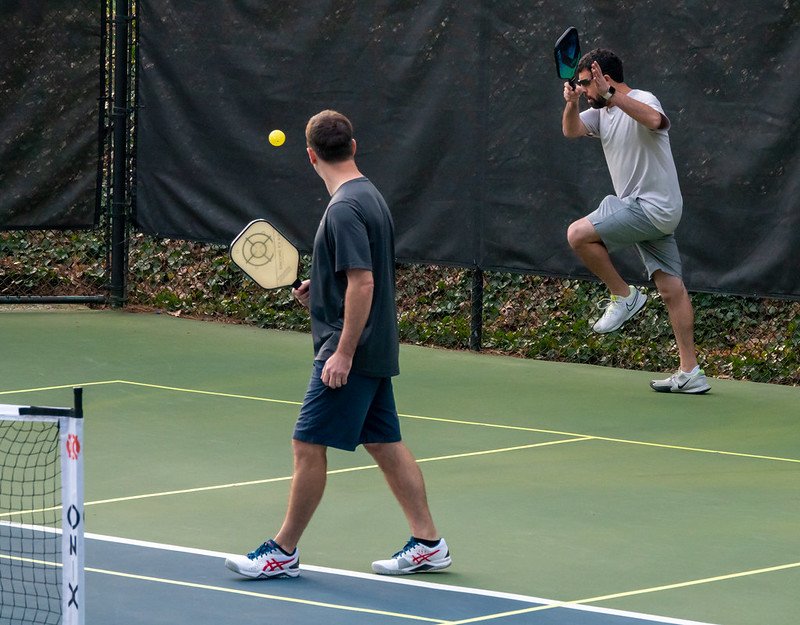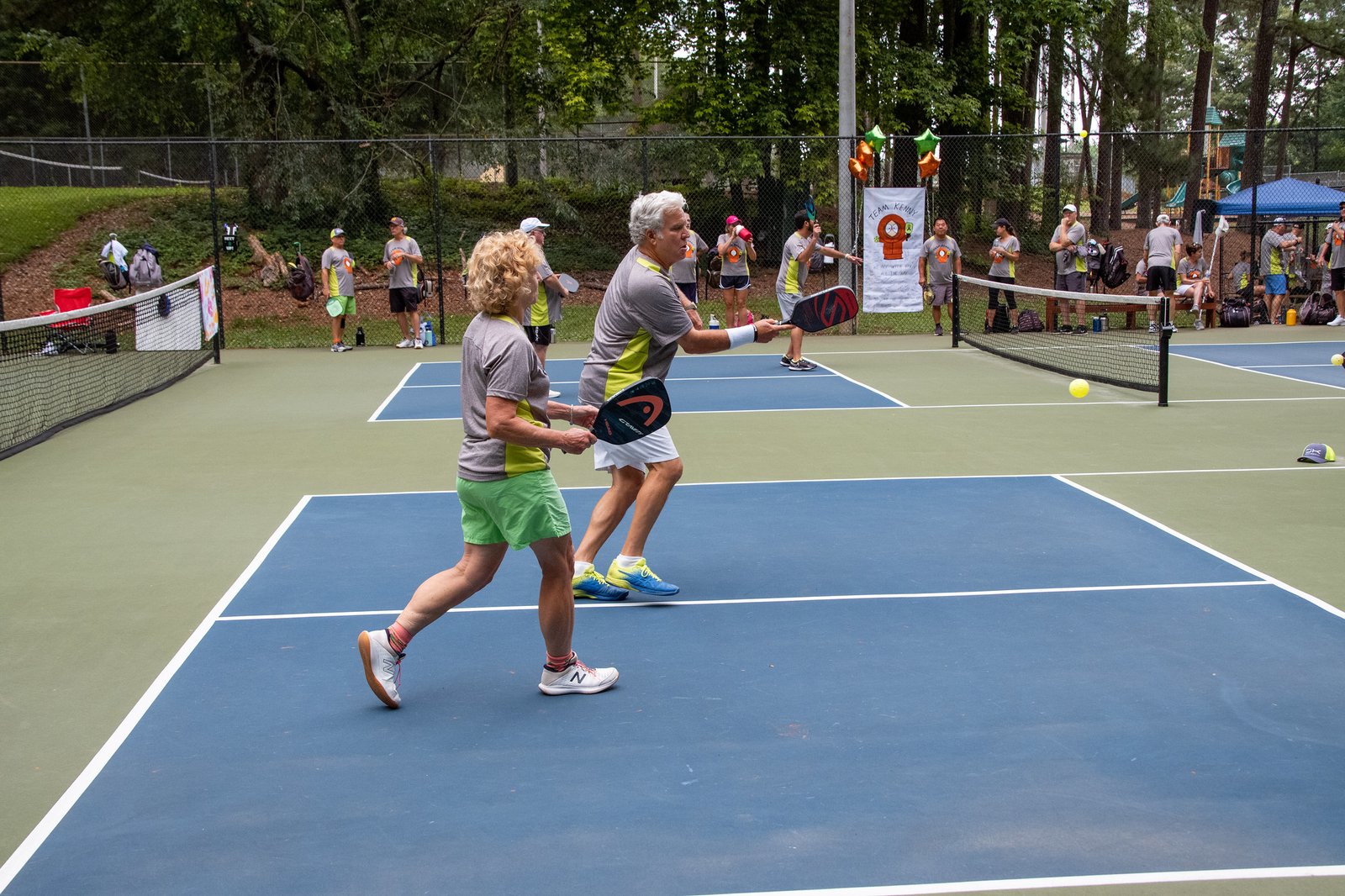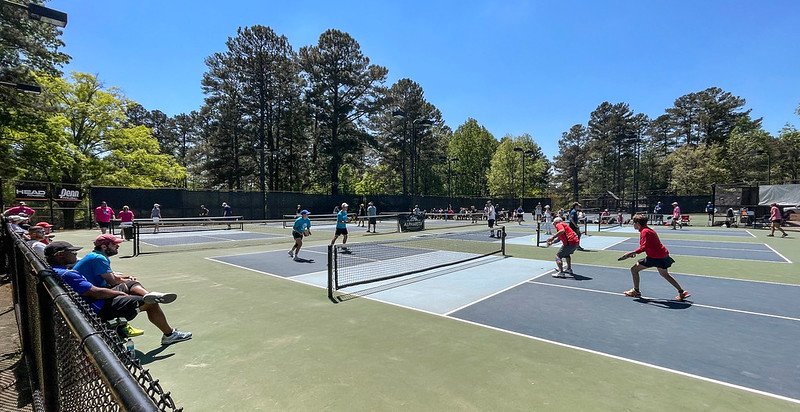Pickleball, a dynamic and rapidly growing racquet sport, has captured the hearts of enthusiasts worldwide due to its blend of strategy, agility, and camaraderie. This engaging sport, often likened to a fusion of tennis, badminton, and table tennis, offers a unique and thrilling experience for players of all ages and skill levels. At the heart of the game lie essential elements like Pickleball rules, the non-volley zone, and the Pickleball kitchen, which govern the flow and dynamics of this intriguing sport.
Pickleball is typically played on a rectangular court, with players using solid paddles to volley a perforated plastic ball back and forth over a net. It’s known for its fast-paced rallies and the need for precise shot placement. Understanding the rules and regulations of Pickleball is essential for both beginners and seasoned players to ensure fair play and sportsmanship.
One of the most critical aspects of Pickleball is the non-volley zone, often affectionately referred to as the “kitchen.” This area adjacent to the net serves as a strategic challenge for players, as there are specific rules governing when and how one can interact with the ball within this zone. Players are prohibited from volleying the ball while standing inside the kitchen, emphasizing the need for careful footwork and timing during intense rallies. The non-volley zone adds depth and strategy to the game, rewarding those who can master the delicate art of dinking and shot placement.
Within the context of Pickleball, the Pickleball kitchen is not merely a physical space but a tactical arena where players must make split-second decisions. Whether it’s choosing to volley from the kitchen after the ball has bounced or strategically maneuvering to force opponents into the same predicament, understanding and utilizing the kitchen effectively can make all the difference between victory and defeat.
Table of Contents
In this exploration of Pickleball, we will delve deeper into the rules that shape the sport, the nuances of the non-volley zone, and the strategic significance of the Pickleball kitchen. We’ll uncover the intricacies of this sport, from the serve to the final point, providing insights that will help both newcomers and experienced players elevate their game. So, let’s embark on a journey into the world of Pickleball, where skill, strategy, and sportsmanship collide on the court.

What does non-volley zone mean?
The non-volley zone, often referred to as the “kitchen” in pickleball, is a designated area on the court that plays a pivotal role in shaping the dynamics and strategies of the game. This rectangular region is situated adjacent to the net and extends 7 feet (2.13 meters) on either side of the net, spanning the entire width of the court. It is marked by lines parallel to the net on both sides.
The primary purpose of the non-volley zone is to prevent players from executing volleys, which are shots made by striking the ball out of the air without allowing it to bounce. The specific rules governing the non-volley zone are as follows:
No Volleying from Within the Zone
Players are not allowed to volley the ball while any part of their body, including their feet, is positioned inside the non-volley zone. This rule promotes fair play and prevents overly dominant offensive strategies close to the net.
Post-Bounce Volleys Allowed
After the ball has bounced within the non-volley zone, players are free to step inside and volley it. This encourages a different style of play, emphasising dinking (soft, controlled shots) and strategic positioning near the net.
Kitchen Lines as Boundaries
The lines delineating the non-volley zone are considered part of the zone itself. Thus, if any part of a player’s foot or paddle touches these lines or enters the kitchen, they are considered to be inside the non-volley zone.
In essence, the non-volley zone adds an intriguing layer of strategy to pickleball, requiring players to carefully time their shots, move tactically, and engage in dinking exchanges near the net. It’s a pivotal aspect of the game that ensures fair competition and exciting rallies while emphasizing the importance of precision and finesse in a sport known for its fast-paced action.

What does volley mean in pickleball?
In the context of pickleball, a “volley” refers to a specific type of shot where a player hits the ball out of the air without allowing it to bounce first. This is in contrast to hitting the ball after it has bounced, which is a “groundstroke.” Understanding the concept of volleys is crucial because there are specific rules and restrictions governing when and where volleys are allowed in pickleball.
Pickleball’s rules emphasize fairness and strategy, and one of the key rules is related to the “non-volley zone” or the “kitchen.” According to these rules, players are not allowed to volley the ball while any part of their body, including their feet, is inside the non-volley zone. This restriction is in place to prevent players from dominating the game with aggressive net play.
Volleys are often used during intense rallies, as they allow players to put pressure on their opponents by hitting the ball with speed and precision. However, due to the non-volley zone rules, players need to be strategic about when to use volleys. They often engage in “dinking,” which involves hitting soft, controlled shots close to the net, as this technique allows them to maintain their position outside the non-volley zone while keeping the ball in play.
So, to summarize a volley in pickleball is a shot where the ball is struck out of the air without bouncing, and understanding when and where to use volleys is crucial for successful play within the sport’s rules and strategies.
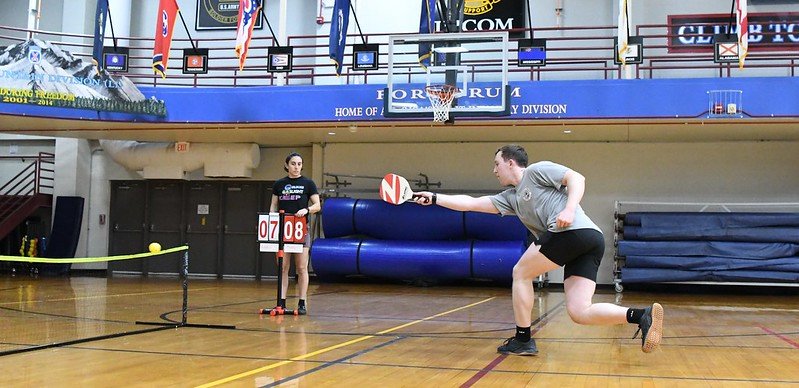
Mastering the Non-Volley Zone
The non-volley zone, often referred to as the “kitchen” in pickleball, is a crucial area on the pickleball court that has specific rules and restrictions governing how players can interact with the ball. Understanding the non-volley zone and its rules is essential for playing pickleball correctly and competitively. Here’s a detailed explanation of the non-volley zone in pickleball:
Location and Dimensions
The non-volley zone in the world of pickleball, is a pivotal and precisely delineated area on the pickleball court. Its unique characteristics significantly influence the gameplay and strategy employed by players.
Stretching across both sides of the court, the non-volley zone forms a rectangular space that is strategically located adjacent to the net. This rectangular region extends precisely 7 feet (approximately 2.13 meters) outward from the net towards each sideline, ensuring it is equidistant from the centerline. The width of this non-volley zone is precisely aligned with the width of the entire court, which is 20 feet (about 6.1 meters) in the context of doubles play and slightly wider at 22 feet (approximately 6.7 meters) in the case of singles play.
To clearly demarcate this significant area, the non-volley zone is meticulously marked with distinct lines on each side of the court. These lines run parallel to the net, creating a boundary that players must respect and adhere to during the course of the game. These lines, commonly referred to as “kitchen lines,” serve as a constant reminder of the rules governing the non-volley zone.
Understanding the dimensions and significance of the non-volley zone, often described as the heartbeat of pickleball strategy, is essential for players. It’s within this area that numerous crucial decisions and maneuvers are made, from well-timed volleys to strategic footwork, as players navigate the complex interplay of rules and tactics that define this captivating racquet sport.
Purpose
The non-volley zone in pickleball plays a pivotal role in shaping the sport’s dynamics and promoting fair play. This designated area adjacent to the net isn’t just a random feature but a strategic component carefully integrated into the game’s rules to enhance its balance and strategy.
Its primary purpose is to ensure that pickleball remains a game of skill, finesse, and tactical thinking, rather than a contest of sheer power and dominance at the net. By restricting players from volleying the ball while standing close to the net, the non-volley zone levels the playing field, allowing for a more engaging and competitive experience for participants of all skill levels.
Without the non-volley zone, the game might devolve into a series of quick, aggressive volleys close to the net, making it challenging for players to engage in more extended rallies or exhibit their full range of skills. The presence of the non-volley zone encourages players to strategically position themselves, use precise shot placement, and engage in well-timed dinking exchanges. This adds depth and variety to the gameplay, fostering a dynamic and engaging experience that appeals to a wide range of players, from beginners to advanced competitors.
The non-volley zone isn’t just a physical area on the court; it’s a key component that keeps pickleball exciting, balanced, and accessible to players of all ages and abilities. It underscores the sport’s emphasis on skill, strategy, and sportsmanship, making every point a product of thoughtful play rather than raw power.

Rules Governing the Non-Volley Zone
In pickleball, adherence to the rules governing the non-volley zone is fundamental to maintaining fair play and strategic gameplay. The non-volley zone, often colloquially termed the “kitchen,” encompasses a crucial part of the court adjacent to the net. Within this zone, specific regulations dictate how players can interact with the ball.
Firstly, players are strictly prohibited from volleying the ball, meaning hitting it out of the air without allowing it to bounce, while their feet are positioned inside the non-volley zone. This rule encourages a more strategic and controlled style of play, preventing players from dominating the net and promoting a diverse range of shots.
However, players can strategically step into the non-volley zone after the ball has made contact with the ground inside it, often referred to as a “bounce shot.” This allows for well-placed and calculated shots, encouraging thoughtful maneuvering on the court.
Furthermore, the non-volley zone lines are an integral part of the regulation area. If any part of a player’s foot touches the line or enters the kitchen, they are considered to be inside the non-volley zone. This meticulous rule ensures players adhere to the defined boundaries, promoting fair and consistent gameplay while fostering a competitive and enjoyable atmosphere on the pickleball court.
Common Non-Volley Zone Violations
In pickleball, the non-volley zone plays a critical role in shaping the dynamics and strategy of the game. Adhering to the rules associated with this zone is fundamental to fair play and maintaining the integrity of the sport. Violating these rules incurs faults, impacting the flow of the game and potentially resulting in the loss of points.
Firstly, stepping into the non-volley zone before the ball has bounced is a common fault. To ensure fair play, players must allow the ball to bounce before attempting to play it while within this zone. Stepping in prematurely violates this fundamental principle.
Secondly, volleying the ball while any part of a player’s body or paddle is inside the non-volley zone (except after a bounce) is prohibited. This rule prevents players from gaining an unfair advantage by volleying near the net, encouraging more strategic play, and preventing overly aggressive tactics.
Lastly, serving from inside the non-volley zone is another critical fault. The serve is a fundamental part of the game, and serving from behind the baseline ensures a fair and level playing field for both sides. This rule maintains the balance between serving and receiving, promoting a competitive and engaging experience in the sport of pickleball. Adhering to these non-volley zone rules is crucial for players to play the game with sportsmanship and skill, creating an enjoyable environment for all participants.

Consequences of a Non-Volley Zone Violation
In pickleball, abiding by the non-volley zone rules is a fundamental aspect of fair play and strategy. The non-volley zone is a designated area near the net where players are restricted from volleying the ball. Violating these rules leads to a fault, and the opposing team is awarded a point.
A fault in pickleball occurs when a player fails to adhere to the regulations, and it can transpire during various stages of the game. Whether it’s a serve, a return, or any other shot attempt, if a player steps into the non-volley zone and volleys the ball directly without allowing it to bounce first, it constitutes a fault. The fault is a consequential penalty that affects the score.
The opposing team benefits from the fault by gaining a point, thus emphasizing the significance of maintaining proper positioning and following the non-volley zone guidelines. This rule ensures a level playing field, preventing players from dominating the game with aggressive volleys from the kitchen. It also encourages strategic and thoughtful gameplay, prompting players to engage in skillful shot selection and footwork while maneuvering within the non-volley zone. By upholding these rules, the integrity of the game is preserved, promoting a balanced and enjoyable playing experience for all participants.
Strategies and Tactics
In the world of pickleball, the non-volley zone, has revolutionized gameplay strategies, giving rise to the artful technique known as “dinking.” This crucial part of the court, located just inches from the net, is where players converge to engage in precise, soft shots aimed at initiating a dinking rally.
Dinking is a strategic approach wherein players delicately tap the ball over the net, almost caressing it, to maintain a low trajectory and reduce the opponent’s chance for an aggressive return. This controlled play involves finesse and precision, allowing players to maintain longer rallies, tire out their adversaries, and ultimately gain a strategic advantage. The goal is to maneuver the ball skillfully, often with a slight arc, just over the net, making it challenging for opponents to generate a powerful offensive response.
Additionally, the non-volley zone creates a tactical battlefield where players attempt to manipulate their opponents into violating the no-volley rule. By coaxing their rivals into volleying while still within the kitchen boundaries, players can seize the opportunity to capitalize on their opponent’s fault, gaining a precious point and potentially shifting the momentum of the game. This calculated maneuvering within the non-volley zone amplifies the strategic depth of pickleball, underscoring the significance of mastering both the offensive finesse of dinking and the defensive prowess of kitchen dynamics.
In the world of pickleball, mastering the non-volley zone rules is not just a matter of abiding by the regulations; it’s a key aspect of playing the game effectively and competitively. The non-volley zone, often lovingly called the “kitchen,” is a focal point where finesse and strategy converge to influence the outcome of matches.
Understanding the non-volley zone rules is crucial because it impacts how players approach their shots and positioning. To succeed, players must become adept at “dinking,” a soft and controlled shot technique that keeps the ball low over the net. Dinking allows for more extended rallies, giving players opportunities to exploit their opponent’s weaknesses.
Strategic positioning near the kitchen is equally vital. Players often use the non-volley zone to force their opponents into making errors. They engage in a cat-and-mouse game, attempting to lure their rivals into volleying from within the kitchen, which could result in faults.
The non-volley zone is not merely a line on the court; it’s the epicenter of tactical thinking and execution in pickleball. Mastering this aspect of the game empowers players to control the pace, outmaneuver opponents, and ultimately claim victory while navigating the intricate dance around the kitchen.

